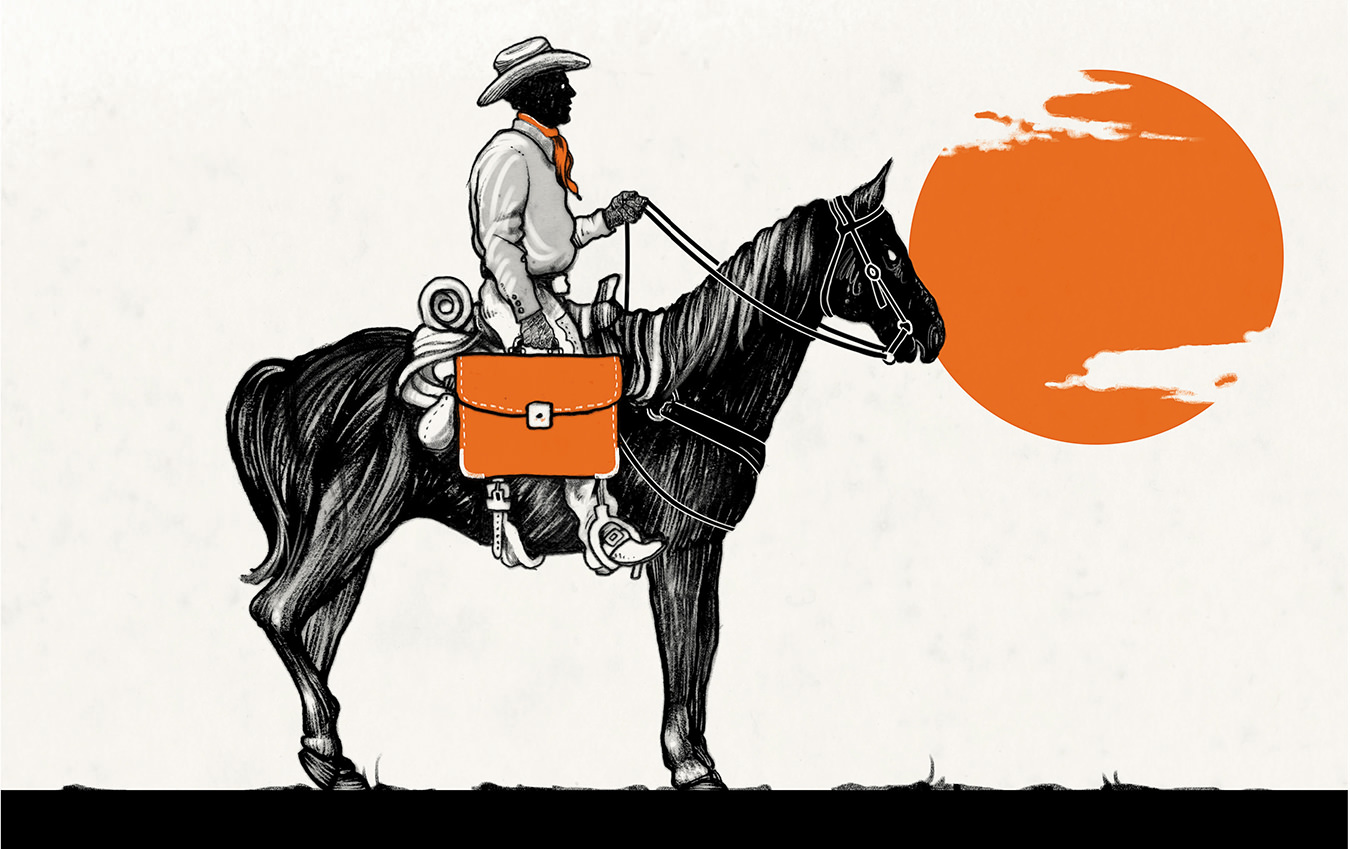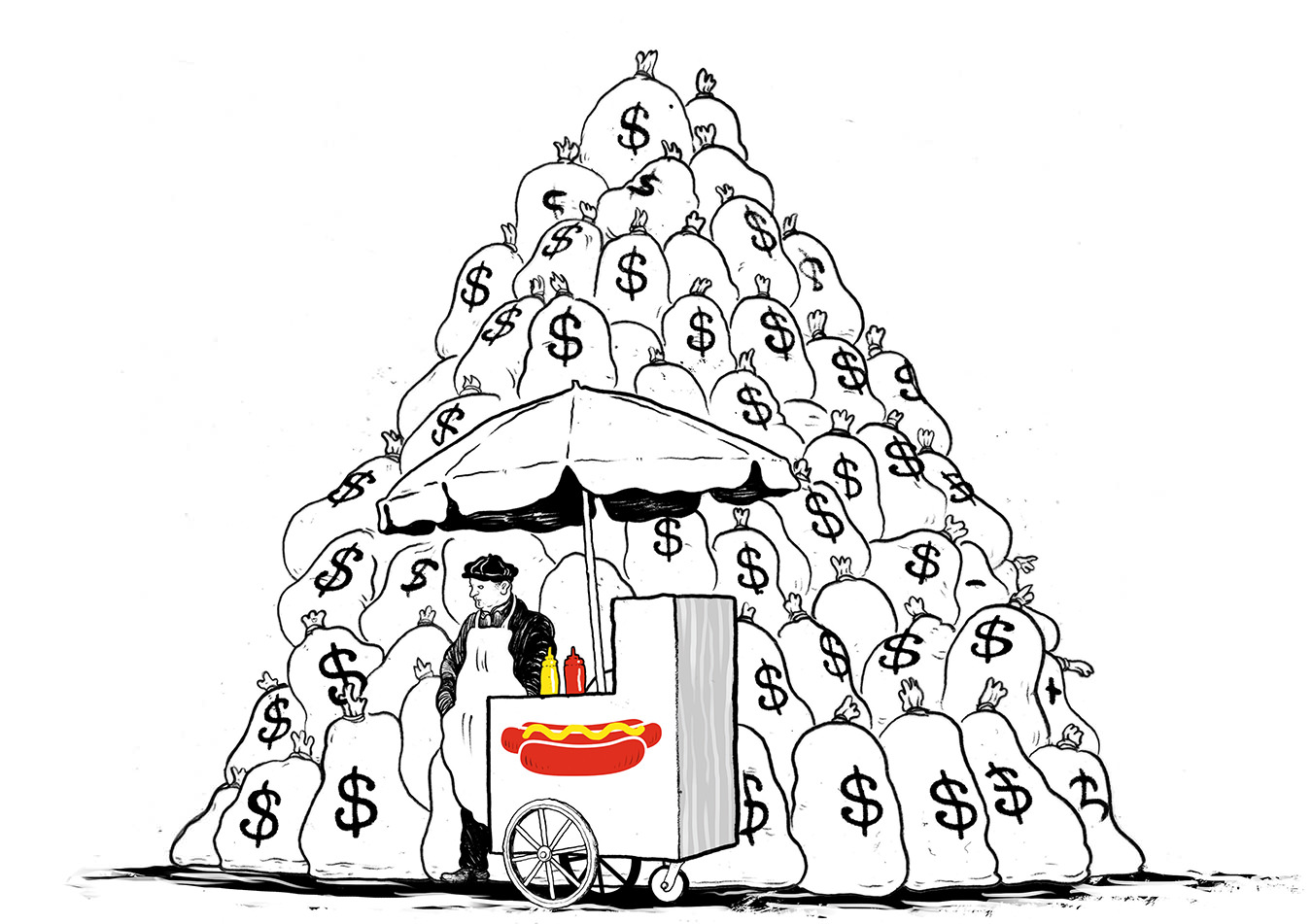Brave New World
Are frontier markets the place to put your money?

Illustration by David Foldvari.
It was all Jim O’Neill’s fault. In November 2001, the chair of Goldman Sachs’ asset management division started talking about how the BRIC countries—Brazil, Russia, India, China—would soon outstrip the developed nations and come to rule the economic world.
Looking back, you can almost see the cogs turning in O’Neill’s head. The BRIC acronym was a clever, memorable, and ultimately marketable way to explain what was in fact a complex narrative of growth, investment, and international capital flow. The kind of stick-in-your-head sound bite that would make it easier to (a) get invited on cable news shows and wax poetic about the bank’s considerable investment expertise, and (b) sell a bunch of mutual funds, ETFs, private equity pools, and other products that would bring in gobs of cash.
O’Neill’s prediction wasn’t just marketing hype—at least not all of it. From 2001 to 2011, the BRIC economies grew four times faster than the U.S. economy. China climbed several rungs up the economic ladder to become the world’s second-largest economy. India now has one of the largest populations of middle-class individuals in the world—upwards of 170-million, by some estimates. Brazil and Russia have become the world’s go-to suppliers of oil, gas, iron ore, and whole mountains of other raw materials the world needs.
At the same time as the BRIC economies were growing, so too was the demand for BRIC-based investments. In the decade after O’Neill made his famous prediction, mutual fund investors poured more than $70-billion into BRIC-related funds. They were handsomely rewarded for their boldness: BRIC stocks quadrupled the gains of the broad-based S&P 500 Index over that time.
There was only one problem: Was the association really accurate? Beyond the nifty play on words, what exactly did the BRIC economies have in common? Why should investors buy stocks from the BRICs instead of, say, the MISTs (Mexico, Indonesia, South Korea, and Turkey)? Or the CARTs (Côte d’Ivoire, Argentina, Romania, and Tunisia)? Or the NECKs (Nigeria, Ecuador, Croatia, and Kazakhstan)? Or any other randomly chosen four-pack of economies whose first letters just so happen to form a common English word?
While the BRICs were making investors money hand over fist, such questions hardly mattered. Once the profits dried up, however, they became harder to ignore. And so it was that investors began looking beyond the BRICs to the so-called frontier markets: countries with smaller economies and less liquidity, further down on the development scale than the BRIC heavyweights.
Which countries constitute the frontier markets? There is little agreement. You say Turkey; I say Tunisia. You say Botswana; I say Bulgaria. However the pundits may quibble, there can be little doubt about their potential. Compare, for example, two U.S.-based offerings from one of the world’s great emerging-markets managers, Templeton Funds. If you had invested $10,000 in the Templeton Frontier Markets Fund at the start of April 2010, you would have $11,369 today—a total return of 11.3 per cent. If you had chosen the Templeton BRIC Fund instead, you would have only $7,899—a 21 per cent loss over the same period.
Located at the border between civilization and the great unknown, between the rule of law and the law of the jungle, the frontier can be a wild and unpredictable place. Ditto frontier markets. Their position just this side of the heart of economic darkness makes them particularly prone to volatility. Not every dollar invested comes back whole.
Should that stop you from putting your money to work in these parts of the world? Tough to say. Clearly, with plenty of growth ahead of them, frontier markets have the potential for exponential (perhaps astronomical) returns. Then again, they said that about dot-com stocks, didn’t they? And mortgage-backed securities. And gold. And Vancouver condos. And… well, you get the idea.
Old World; New World
David Wickham shrugs off such concerns. In his role as director of global emerging markets and frontier markets equity at global mega-bank HSBC, Wickham has had the opportunity to visit a lengthy list of frontier markets. From what he can see, the investment case for frontier markets is a completely logical one—an argument based on facts, not fear.
“Frontier markets are pre-emerging or ‘verging-on-emerging’ countries at an earlier stage of institutional and economic development,” Wickham says. “Given the starting point of these markets, with high institutional voids—i.e. an absence of hard and soft infrastructure—and low productivity, even modest improvements can generate significant productivity gains and return-on-equity for investors.”
Wickham rattles off several ongoing positive changes that tend to define the frontier markets: improving communications and infrastructure, strengthening capital markets, human development and deepening labour markets, improved regulation, reduced bureaucracy and corporate interference, more effective mechanisms for enforcing contracts, and so on. As Wickham explains, such developments have a direct impact on productivity, encouraging the development of favourable political policies, fostering greater knowledge accumulation and R&D, and improving social infrastructure (health, education, and women’s empowerment). “In turn, this productivity growth can result in greater profits and dividend distributions to shareholders, better wages and working conditions, lower prices for consumers, and increased tax payments to governments,” he says.
Which countries constitute the frontier markets? There is little agreement. You say Turkey; I say Tunisia. You say Botswana; I say Bulgaria. However the pundits may quibble, there can be little doubt about their potential.
Wickham points to Sri Lanka as an example. The island nation is just now emerging from a lengthy civil war with the separatist Tamil Tigers. Since the conclusion of the war in May 2009, foreign capital has been flowing into the country, fuelling rapid reconstruction as well as a rebirth of its tourism industry. The government has focused on expanding transportation infrastructure (roads and ports) as well as investing in alternative energy. Investors have benefited greatly from the good-news story: from May 2009 to May 2011, the country’s stock market posted a 286 per cent gain.
This is a fundamentally different situation than BRIC countries such as China, or other emerging markets further on in their development such as South Korea. “Many of the mainstream emerging market countries, such as the BRIC grouping, have already benefited from reduced institutional voids and the resulting productivity gains,” Wickham says. “Many of the large emerging-market countries are now going through phases of transition, as governments focus on stabilizing their economies following [a] period of rapid institutional and economic growth.”
Beyond the big picture, Wickham sees a lot of reasons investors might find frontier markets attractive right now. Among them are the cash that frontier markets throw off: current dividend yields in frontier markets (4.0 per cent) are superior to both emerging markets (2.8 per cent) and the developed markets (2.6 per cent). Another reason is the price. Frontier markets are, to put it plainly, cheap, trading at an average 1.5 times book value. Compare that to 1.6 times book for emerging markets and 1.9 times book for developed markets.
As for risk, Wickham acknowledges that when it comes to frontier markets, there’s plenty of it to go around. “The potential for high returns does not come without some risk,” he admits sagely. While some of these risks are within the investors’ control (for example, how much illiquidity one is willing to accept in the pursuit of higher returns), others, such as political risk, are not. Yes, it’s hard to know whether a government halfway around the world might change regulation or nationalize an otherwise profitable enterprise. But it happens.
That said, Wickham does believe that the reputation of frontier markets as being the Wild West of the investment world is in many ways undeserved. Sure, investors who go all-in on a single company in a far-flung part of the world are doing little more than gambling. But on a broader level, frontier markets offer a compelling offset to other portions of the portfolio.
The Final Frontier
How should investors put frontier markets to work in the portfolio? Because of the country-specific risks that abound, Wickham believes this is no place for passive index investing.
“Frontier markets are less researched and less liquid than emerging and developed equity markets,” Wickham notes. “[They’re] largely dominated by local retail investors who are less affected by global sentiment.” As he explains, such features mean frontier markets are highly inefficient, providing opportunities for active managers to use fundamental analysis to beat the market—although such an approach requires hands-on research and a lot of travel.
As for specific opportunities, Wickham offers a grab bag of intriguing ideas from the nooks and crannies of the investment world. “In aggregate, frontier markets are currently cheaper than both emerging markets and developed markets,” he says. “[But] there is a large dispersion of valuations and some frontier countries are cheaper than others.”
One country Wickham likes is Nigeria. “[It] remains the favoured market in Sub-Saharan Africa despite a strong rebound in 2012,” he says. “A positive macroeconomic outlook should enable earnings trends to continue to improve, resulting in cheap valuations.”
To Wickham, Asia is a mixed bag, with some economies looking overpriced and others looking underpriced. “Valuations in the Philippines are still unattractive although the economy continues to perform well,” says Wickham. “Pakistan is a favoured country in the region, with relatively cheap valuations, a high dividend yield, continued discussions with the IMF, and improved relations with America.”
On the other side of the spectrum is Latin America, where Wickham and his team remain meaningfully underweight (by 6.2 per cent) to their bespoke benchmark. “We remain underweight based on expensive valuations in Colombia and Peru,” he says. “We continue to monitor the ongoing legal cases involving Argentina’s sovereign debt and possible changes in economic policy.”




